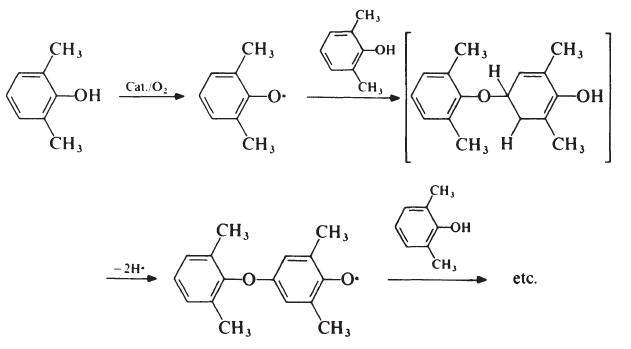| Identification | Back Directory | [Name]
POLY(2,6-DIMETHYL-1,4-PHENYLENE OXIDE) | [CAS]
25134-01-4 | [Synonyms]
2,6-dimethyl-phenohomopolymer
Phenol,2,6-dimethyl-,homopolymer
POLY(2,6-DIMETHYL-P-PHENYLENE OXIDE)
POLY(2,6-DIMETHYL-1,4-PHENYLENE OXIDE)
POLY(2,6-DIMETHYLENE-P-PHENYLENE OXIDE)
2,6-DIMETHYL-1,4-PHENYLENE OXIDE POLYMER
2,6-dimethyl-1,4-phenylene oxide homopolymer
Poly(2,6-diMethyl-1,4-phenylene oxide) powder
POLY(2,6-DIMETHYL-1,4-PHENYLENE OXIDE), SECONDARY STANDARD
Poly(2,6-dimethyl-1,4-phenylene oxide), approx. M.W. 50,000
Poly(2,6-dimethyl-1,4-phenylene oxide) analytical standard, Mw 30,000 (Typical), Mn 20,000 (Typical) | [Molecular Formula]
(C8H10O)x | [MDL Number]
MFCD00084368 | [MOL File]
25134-01-4.mol | [Molecular Weight]
122.164 |
| Hazard Information | Back Directory | [Chemical Properties]
white to off-white powder | [Uses]
Imidazolium modified PPO with liquid ionic graphene oxide can be used as an anion exchange membrane (AEM) composite with a peak power density of 136 mW cm?2 for use in the fabrication of high performance fuel cells. It may also be sulfonated to form a long chained polymeric structure with an efficiency of 81.8% at a current density of 120 mA cm?2 for potentiall use in vanadium redox flow batteries (VRFBs) as effective energy storage systems. It may also be used in the formation of AEMs, which can be used in the development of microbial desalination cell system (MDCS). | [Definition]
ChEBI: 2,6-Dimethylphenol is a hydroxytoluene. | [Preparation]
Oxidative coupling is readily accomplished by passing oxygen into a reaction
mixture containing 2,6-xylenol, pyridine and cuprous chloride. (The molar
ratio of pyridine to cuprous ion is generally in the range 10: 1 to 100: 1.)
External heating is unnecessary; during the course of the reaction the
temperature rises to about 70??C. The polymer is precipitated with dilute
hydrochloric acid and collected by filtration.
It is generally accepted that aryloxy radicals are intermediates in the
polymerization reaction since ESR studies have shown the presence of both
monomeric and polymeric aryloxy radicals in polymerizing solutions of 2,6-
xylenol. The simplest mechanism that can be suggested for the reaction is
aromatic substitution:

| [General Description]
Poly(2,6-dimethyl-1,4-phenylene oxide) (PPO) is an anion exchange membrane (AEM) material that is mainly used as a cross-linker in which the methyl groups are used to bond with ultraviolet (UV) excited ketones. |
|
| Company Name: |
SRIKAR Labs
|
| Tel: |
+91-9490599901 +91-9177846399 |
| Website: |
www.srikarlabs.com |
| Company Name: |
Energy Chemical
|
| Tel: |
021-021-58432009 400-005-6266 |
| Website: |
http://www.energy-chemical.com |
| Company Name: |
Sigma-Aldrich
|
| Tel: |
021-61415566 800-8193336 |
| Website: |
https://www.sigmaaldrich.cn |
|